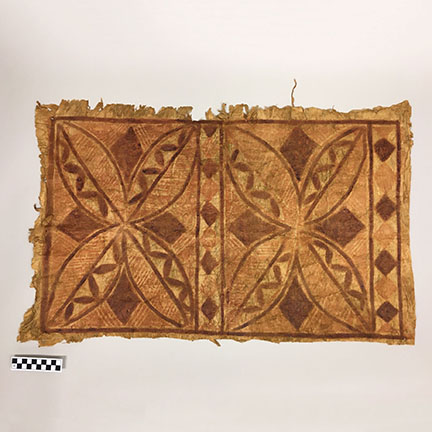

Samoan Tapa Cloth (83.13.1)
This tapa cloth, likely made from paper mulberry (Broussonetia papyrifera) bark, was gifted to donor Ira L. Kessler by a Samoan chief in 1943. The cloth’s age is evident by its tattered and fraying edges. The front side of the cloth has a design in light brown and peach.
Tapa (or saipo) cloth is a paper-like fabric made primarily from the bark of paper mulberry trees. Produced throughout Polynesia, tapa is a versatile fabric, tapa cloth is used for clothing, room dividers, floor mats, mosquito screens, as well as for ceremonial purposes. Bark cloth textiles are not unique to Polynesia, and are also made in Melanesia, South and Central America, South Africa, and Australia.
Made in a process similar to felting, in Polynesia, tapa production is a highly skilled woman’s craft associated with female identity. Branches are collected and the bark is stripped and soaked in water until extremely soft. The waterlogged bark is then scraped and pounded to form a pulp, then beaten with specially carved wooden or whalebone bats to form a dense cloth. Tapa cloth often has a patchwork-like texture as the bark pulp is beaten on top of itself and arranged in layers. Finished cloths are often decorated with regionally specific stamped and painted designs. The fineness of the cloth reveals the artist’s skill and social status. In pre-colonial Tahiti, the social elite was renowned for their delicate tapa cloth. Varying grades of tapa signaled social status, with island royalty creating and wearing tapa “almost as thin as muslin” (Reynolds 194).
Although both men and women wear tapa cloth garments and may assist in both carving the tools used and selling the cloth, the process of creating the cloth is associated with female labor. Women maintain the paper mulberry plantations; gather, strip and beat the bark; and create dyes and designs to apply to the finished bark cloth. The creation process is so exclusive that men and children are banned from witnessing the preparation and application of design. The continued production and sale of tapa cloth into the twenty-first century has provided women greater financial stability and independence (Barker and Hermkens 2016,194).
By Petra Brown
References and Resources
To see the steps of Samoan bark cloth manufacture as described by Tapa artist Mary Pritchard visit http://www.siapo.com/bark-cloth.html
Rhode Island School of Design Museum, Pacific Islands Tapa Cloth | RISD Museum
Museum of Natural and Cultural History, University of Oregon https://mnch.uoregon.edu/collections-galleries/tapa-cloth
Barker, John and Hermkens, Anna-Karina. 2016. “The Mothers’ Union goes on strike: Women, tapa cloth and Christianity in a Papua New Guinea Society.” The Australian Journal of Anthropology 27: 185-205.
Reynolds, Pauline. 2016. “Tapa Cloths and Beaters: Tradition, Innovation and the Agency of the Bounty Women in Shaping a New Culture on Pitcairn Island from 1790 to 1850.” Textile History 47 (2): 190–207.